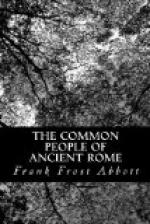In the preceding pages we have tried to find out the main features of popular Latin. In doing so we have constantly thought of literary Latin as the foil or standard of comparison. Now, strangely enough, no sooner had the literary medium of expression slowly and painfully disassociated itself from the language of the common people than influences which it could not resist brought it down again to the level of its humbler brother. Its integrity depended of course upon the acceptance of certain recognized standards. But when flourishing schools of literature sprang up in Spain, in Africa, and in Gaul, the paramount authority of Rome and the common standard for the Latin world which she had set were lost. When some men tried to imitate Cicero and Quintilian, and others, Seneca, there ceased to be a common model of excellence. Similarly a careful distinction between the diction of prose and verse was gradually obliterated. There was a loss of interest in literature, and professional writers gave less attention to their diction and style. The appearance of Christianity, too, exercised a profound influence on literary Latin. Christian writers and preachers made their appeal to the common people rather than to the literary world. They, therefore, expressed themselves in language which would be readily understood by the average man, as St. Jerome frankly tells us his purpose was. The result of these influences, and of others, acting on literary Latin, was to destroy its unity and its carefully developed scientific system, and to bring it nearer and nearer in its genius to popular Latin, or, to put it in another way, the literary medium comes to show many of the characteristics of the spoken language. Gregory of Tours, writing in the sixth century, laments the fact that he is unfamiliar with grammatical principles, and with this century literary Latin may be said to disappear.
As for popular Latin, it has never ceased to exist. It is the language of France, Spain, Italy, Roumania, and all the Romance countries to-day. Its history has been unbroken from the founding of Rome to the present time. Various scholars have tried to determine the date before which we shall call the popular speech vulgar Latin, and after which it may better be styled French or Spanish or Italian, as the case may be. Some would fix the dividing line in the early part of the eighth century A.D., when phonetic changes common to all parts of the Roman world would cease to occur. Others would fix it at different periods between the middle of the sixth to the middle of the seventh century, according as each section of the old Roman world passed definitely under the control of its Germanic invaders. The historical relations of literary and colloquial Latin would be roughly indicated by the accompanying diagram, in which preliterary Latin divides, on the appearance of literature in the third century B.C., into popular Latin and literary Latin. These two forms of speech develop along independent lines until, in the sixth century, literary Latin is merged in popular Latin and disappears. The unity for the Latin tongue thus secured was short lived, because within a century the differentiation begins which gives rise to the present-day Romance languages.




